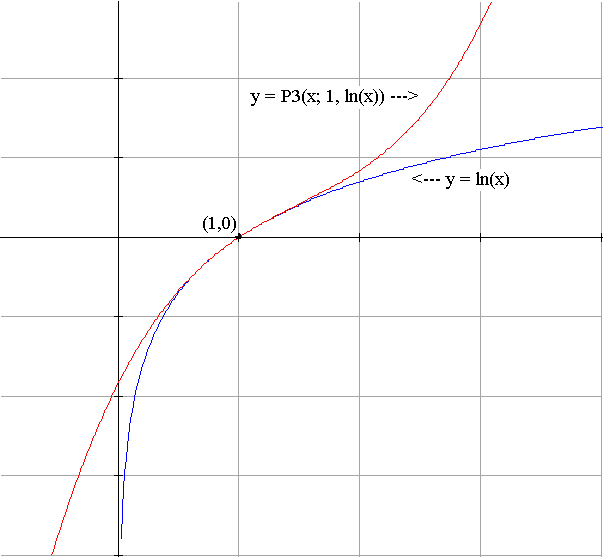
In the previous work using Maclaurin's polynomials, the focus
of attention has been on estimating the values of a function f
based
on information developed when x=0. To find
estimating
polynomials
Pn
(x) for the function f
expressed
in
powers
of
x we have
calculated f(0),
f
'(0), f ''(0), and so on. For some functions it is
impossible
or at least inconvenient to find this information related to x
=
0. However,often it is still possible to
evaluate a
function and its
derivatives
at another point in the domain, say x = a.
Taylor's
theory
can handle this additional generality quite easily based on our
previous
work at x=0. The main theorem of this chapter states the
most
general
result, which we will refer to as Taylor's Theorem. Before
stating and
proving this theorem, we consider the Taylor polynomial for a `C^{oo}`
function at x=a which generalizes the Maclaurin
polynomial.
Definition IX.D.1: Suppose f is a `C^{oo}` function in an interval containing x = a. Let
`P_n(x;a,f(x)) = f(a) +
f'(a)(x-a)
+ {f''(a)}/{2!}(x-a)^2
+...+{f^{(n)}(a)}/{n!}(x-a)^n`.
`P_n(x;a,f(x))` is called the Taylor polynomial of degree n for f at x=a.
Example IX.D.1: Find `P_3(x;1,ln(x))`.
Solution: We compute the appropriate coefficients as follows:
| `f(x) = ln(x)` | `f(1) = 0` |
| `f '(x) = 1/x` | `f '(1) = 1` |
| `f ''(x) = -1/{x^2}` | `f ''(1)=-1` |
| `f '''(x)= 2/{x^ 3}` | `f '''(1)=2` |

Here is the graph of this polynomial compared to that of ln(x).
Note: The Taylor polynomial of f at x = 0 is the Maclaurin polynomial of the same degree for f, i.e.,
The next proposition shows how the Taylor polynomial generalizes the Maclaurin polynomial as the solution to a differential equation.
Proposition IX.D.1:
Suppose f
is a `C^{oo}`
function for an interval containing `x = a` and
let `p(x)
= P_n(x;a,
f(x))`.
Proof: This should be a fairly straight forward exercise.
Theorem IX.D.2:(Taylor's Theorem) Suppose f is a `C^{oo}` function for an open interval I that contains `x = a`. For any `b` in I, `f(b)` is approximately equal to `Pn(b;a,f(x))`. Furthermore, if `R_n(b) = f(b) - P_n(b;a,f(x))` then there is a number `c` between `a` and `b` where
Proof: Consider `g(t) = f ( a + t )`. Essentially `g` shifts the information of the function `f`. The function `g` has its values for points in an interval containing 0. Now apply the main proposition for Maclaurin's polynomials, Theorem IX.B.1, to `g`. Estimate the value of `g` at `x = b-a`. Thus when `b` is close to `a`, `b-a` is close to `0`, so
`f(b) = g(b-a)` is estimated by `P_n(b-a,g(x))`.
But `g(0) = f(a)`, `g'(0) = f '(a)` , ..., and `g^{(n)}(0) = f^{(n)}(a)` , so
`P_n(b-a;a,g(x)) = f(a) +
f'(a)(b-a) + {f''(a)}/{2!}(b-a)^2
+...+{f^{(n)}(a)}/{n!}(b-a)^n =P_n(b;a,f(x))`.
We noted previously that `g(b-a) = f(a + b-a ) = f(b)`, so we have that `f(b)` is estimated by `P_n(b;a,f(x))`.
Now from IX.B.1 there will be a
number
`q` between `0`and `b-a` so that the difference between `g(b-a)`
and `P_n(b-a,g(x))` is equal to
But if we let `c= a+q`, then we have immediately that `c` is between `a` and `b` and
EOP
Example IX.D.1: (Continued) We use `P_3(x;1,ln(x))` to estimate `ln(1.1)` and `ln(.9)`. Since the expression for `P_3(x;1,ln(x))` involves powers of `x-1`, first note that when `x = 1.1`, `x-1=.1` so we have that
Exercises:
In problems 1-10 for the indicated
function f find the Taylor polynomial P
n(x;a,
f(x))
of degree n about x = a. On the same axes,
graph f
(x) and P n(x;a,
f(x)).